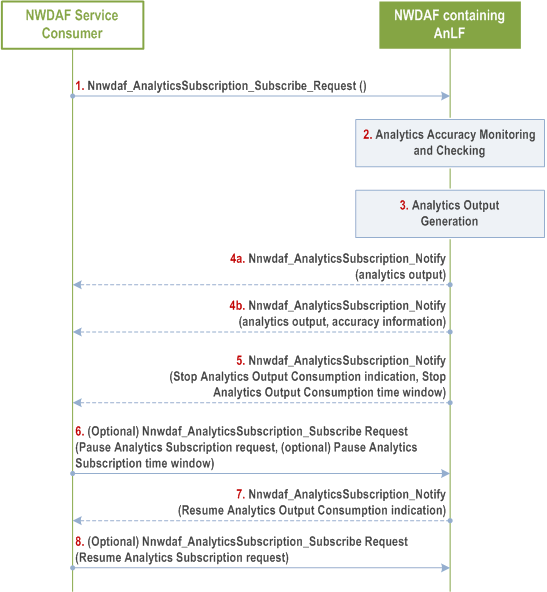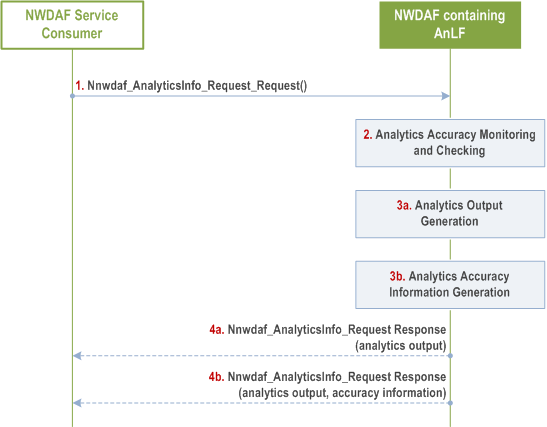Content for TS 23.288 Word version: 18.6.0
1…
4…
5…
5A…
6…
6.1.3
6.1.4…
6.1.4.4…
6.1.5…
6.1A…
6.1B…
6.1B.2.3…
6.1C
6.2…
6.2.3…
6.2.6…
6.2.6.2
6.2.6.3…
6.2.6.3.3
6.2.6.3.4
6.2.6.3.5
6.2.6.3.6…
6.2.7…
6.2.8…
6.2.9…
6.2.13…
6.2A…
6.2B…
6.2B.3
6.2B.4…
6.2C…
6.2D…
6.2E…
6.2F…
6.3…
6.4…
6.5…
6.6…
6.7…
6.7.3…
6.7.4…
6.7.5…
6.8…
6.9…
6.10…
6.11…
6.12…
6.13…
6.14…
6.16…
6.17…
6.18…
6.19…
6.20…
6.21…
7…
7.4…
7.7…
7.9…
8…
9…
10…
6.2D AnLF Analytics Accuracy Monitoring Procedures
6.2D.1 General
6.2D.2 Procedures for Analytics Accuracy Information Subscription
6.2D.3 Procedures for Analytics Accuracy Information Request
...
...
6.2D AnLF Analytics Accuracy Monitoring Procedures |R18| p. 141
6.2D.1 General p. 141
The Analytics Accuracy Information comprises a set of parameters as defined in clause 6.1.3.
When multiple NWDAFs are deployed, some NWDAFs may be specialized with the analytics accuracy checking capability. When an NWDAF containing AnLF has the analytics accuracy checking capability, such an NWDAF is able to:
-
Receive a subscription or a request for analytics IDs via Nnwdaf_
AnalyticsSubscription_ or Nnwdaf_Subscribe AnalyticsInfo_ service operation with the indication for activating the mechanisms for checking the accuracy of such analytics ID as defined in clause 6.1.3.Request -
Provide the accuracy information to the consumer via Nnwdaf_
AnalyticsSubscription_ or Nnwdaf_Notify AnalyticsInfo_ response service operation.Request
6.2D.2 Procedures for Analytics Accuracy Information Subscription p. 141
This procedure is used by NF consumers of analytics ID to subscribe to receive analytics output and Analytics Accuracy Information related to the requested analytics ID for NF consumer. Figure 6.2D.2-1 shows the procedure for accuracy information subscription and provisioning.

Step 1.
The NWDAF service consumer selects the appropriated NWDAF containing AnLF according to clause 5.2 and subscribes or modifies the subscription for Analytics Accuracy Information by invoking the Nnwdaf_AnalyticsSubscription_Subscribe service operation. The parameters that can be included in the subscription to trigger the accuracy information checking and provisioning are listed in clause 6.1.3.
If the subscription is not the initial subscription request, it may include Analytics Feedback Information as described in clause 6.1.1.
Step 2.
When a subscription request is received, the NWDAF containing AnLF verifies the parameters of the Analytics Accuracy Request information received from the NWDAF service consumer in step 1.
The NWDAF containing AnLF starts the Analytics Accuracy Monitoring and generation of the Analytics Accuracy Information related to the analytics ID indicated in the subscription according to the parameters defined in Analytics Accuracy Request Information in clause 6.1.3. The NWDAF containing AnLF is to compute Analytics Accuracy Information according to the methods in clause 6.2D.1. If the NWDAF containing AnLF does not have enough necessary data, it will perform step 3b to collect ground truth data before computing Analytics Accuracy Information.
The NWDAF containing AnLF may have started to perform the Analytics Accuracy Monitoring and Analytics Accuracy Information generation, triggered by other NWDAF service consumer(s) before. Upon receiving a new request from the NWDAF service consumer, the NWDAF containing AnLF determines whether new data collection is needed for Analytics Accuracy Information generation based on the corresponding analytics subscription.
In addition to the received request from the NWDAF service consumer, based on local policy, the NWDAF containing AnLF may determine to start the Analytics Accuracy Monitoring and Analytics Accuracy Information generation.
Step 3a.
The NWDAF containing AnLF performs the data collection for the subscribed analytics ID and generates the analytics output.
Step 3b.
The NWDAF containing AnLF performs the data collection (e.g., ground truth data collection) for accuracy information generation for the subscribed analytics ID and generates the associated Analytics Accuracy Information. If Analytics Feedback Information is included in step 1, the NWDAF containing AnLF may take it into account and determine whether it affects the ground truth data by the internal logic to generate Analytics Accuracy Information.
Step 4a.
The NWDAF containing AnLF provides the analytics output according to the parameters defined in Analytics Reporting Information included in the subscription request when there is no Analytics Accuracy Request Information included in the subscription in step 1.
Step 4b.
The NWDAF containing AnLF provides the Analytics Accuracy Information together with the analytics output for the analytics ID according to the parameters defined in the Analytics Accuracy Request Information included in the subscription request.
Step 4c.
The NWDAF containing AnLF provides only the Analytics Accuracy Information for the analytics ID according to the parameters defined in the Analytics Accuracy Request Information included in the subscription request. The Analytics Accuracy Information is provided in a separated notification when the periodicity for providing the Analytics Accuracy Information indicated in the Analytics Accuracy Request Information is different from the periodicity for providing the analytics output indicated in the subscription request, or the accuracy value is under the analytics accuracy threshold which is indicated in the subscription request or locally configured.
Step 5.
When determining the low or insufficient accuracy for an analytics ID, i.e. the deviation of the analytics output using the trained ML Model from the ground truth data (which are collected from Data Producer NF corresponding to the requested analytic ID at the time which the prediction refers to) does not meet analytics accuracy requirement, which indicates the accuracy value is under the analytics accuracy threshold(s) (which are locally configured or received in the subscribe request), the NWDAF containing AnLF may notify the NWDAF Service consumer with the Stop Analytics Output Consumption indication and the Stop Analytics Output Consumption time window.
Step 6.
(Optional) The NWDAF Service Consumer may decide to stop the consumption of analytics output without unsubscribing to the analytics ID, based on its own logic or based on a received notification from NWDAF with the Stop Analytics Output Consumption indication. The NWDAF Service Consumer invokes the Nnwdaf_AnalyticsSubscription_Subscribe service operation including the Subscription Correlation ID to modify an existing subscription and provides the parameter Pause analytics consumption flag in the Analytics Accuracy Request Information.
Step 7.
When the NWDAF determines an improvement in the accuracy of an analytics ID (e.g. meet the accuracy requirement of the analytics consumer) or when the Stop Analytics Output Consumption time window set by itself is finished, the NWDAF notifies the NWDAF Service Consumer of the accuracy information for the analytics ID to resume the consumption of the analytics output, therefore reactivating an existing analytics ID subscription that has been previously stopped.
Step 8.
(Optional) The NWDAF Service Consumer based on its own logic can notify the NWDAF to resume the notification of analytics output, therefore reactivating an existing subscription to analytics ID that has been paused either by NWDAF Service Consumer request (step 6) or by NWDAF indication (step 5). The NWDAF Service Consumer invokes the Nnwdaf_AnalyticsSubscription_Subscribe service operation including the Subscription Correlation ID to modify an existing subscription and provides the parameter Resume Analytics Subscription request in the Analytics Accuracy Request Information.
6.2D.3 Procedures for Analytics Accuracy Information Request p. 144
This procedure is used by NF consumers of analytics ID to request Analytics Accuracy Information related to the requested analytics ID for NF consumer. Figure 6.2D.3-1 shows the procedure for accuracy information request and response.

Step 1.
The NWDAF service consumer selects the appropriated NWDAF containing AnLF according to Clause 5.2 and requests for Analytics Accuracy Information by invoking the Nnwdaf_AnalyticsInfo_Request service operation. The parameters that can be included in the request to trigger the accuracy information checking and provisioning are listed in clause 6.1.3.
Step 2.
When a request is received, the NWDAF containing AnLF determines whether the request is only for analytics output generation or if it includes the Analytics Accuracy request.
If the Analytics Accuracy request is included, the NWDAF containing AnLF starts the Analytics Accuracy Monitoring and generation of the Analytics Accuracy Information related to the analytics ID indicated in the request and according to the parameters defined in Analytics Accuracy Request Information in clause 6.1.3. The NWDAF containing AnLF is to compute Analytics Accuracy Information according to the methods in Clause 6.2D.1. If the NWDAF containing AnLF does not have enough necessary data, it will perform step 3b to collect ground truth data before computing Analytics Accuracy Information.
The NWDAF containing AnLF may have started to perform the Analytics Accuracy Monitoring and Analytics Accuracy Information generation, triggered by other NWDAF service consumer(s) before. Upon receiving a new request from the NWDAF service consumer, the NWDAF containing AnLF determines whether new data collection is needed for Analytics Accuracy Information generation based on the corresponding analytics request.
In addition to the received request from the NWDAF service consumer, based on local policy, the NWDAF containing AnLF may determine to start the Analytics Accuracy Monitoring and Analytics Accuracy Information generation.
Step 3a.
The NWDAF containing AnLF performs the data collection for the requested analytics ID and generates the analytics output.
Step 3b.
The NWDAF containing AnLF performs the data collection (e.g., ground truth data collection) for accuracy information generation for the requested analytics ID and generates the associated Analytics Accuracy Information.
Step 4a.
The NWDAF containing AnLF provides the analytics output according to the parameters defined in Analytics Reporting Information included in the request, when no Analytics Accuracy Request Information is included in the request in step 1.
Step 4b.
The NWDAF containing AnLF provides the requested analytics output and Analytics Accuracy Information for the analytics ID according to the parameters defined in the Analytics Accuracy Request Information included in the request.